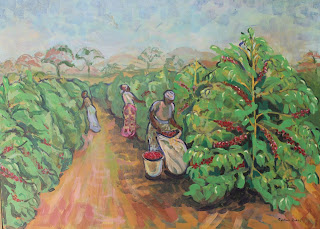By
Andrew Mulenga
“Cynthia
Zukas’ 50 Creative Years” the eponymous solo exhibition by the veteran painter
and printmaker at the Zebra Crossing Café, Ababa House off Cairo Road in Lusaka
celebrates the artists 50 year artistic career on Zambian soil.  |
| Reproduction of a 1971 poster from Cynthia Zukas' first solo exhibition in Zambia |
Particularly through reproduced exhibition posters and photographs the show reveals a Lusaka art scene that has transformed drastically over the years. Whereas the main exhibition venues in the capital today are The Henry Tayali Gallery, 37 d, the Lusaka National Museum, the Alliance Francaise and the Zebra Crossing Café, Zukas’ exhibition conjures the obsolete spaces such as the Lusaka City Library, the British Council, Mpapa Gallery, the Anglo-American Centre and Marco Polo all very active places until the late 1980s. As much as the archival posters reflect a flourishing art scene, it was not always like this, and Zukas actually played an integral role in creating harmony through the early organizations such as the now defunct Lusaka Art Society (LAS) and Art Centre Foundation (ACF) the precursors of the Visual Arts Council. Her roles in these two notable bodies from the early days of contemporary Zambian art are often overlooked.
 |
| Cynthia (left) with Lusaka Mayor Fleetford Chirwa during the opening of her exhibition at the City Library in 1971 |
 |
| Picking Coffee I, (acrylic on canvas) by Cynthia Zukas |
“I had only been here a couple of months and to my utter surprise I was immediately made secretary (of LAS), and I was pretty surprised to find at their annual art exhibition which was open to everybody, still there were no Zambians or no indigenous Zambians at all if you want to use that word. Now one really lucky thing that happened also the same year (1965), I met Bente Lorenz, she had been here before me at least a year or more but before independence,” explains the 85-year-old.
 |
| Too many mouths to feed, etching by Cynthia Zukas |
“The government was very interested in cultural development, both (Simon Mwansa) Kapwepwe and (Kenneth) Kaunda were very vocal, the Department of Cultural Services had a generous grant”. In addition, the first few years after independence the Department of Cultural Services also supported “annual National Arts Festivals”, although Zukas “cannot remember when they stopped but for the first three or five years they were very good, they got off really to a very good start”. The biggest of these events was in 1967 when the department organised “a festival to celebrate the third anniversary of independence” recalls Zukas.
 |
| Stone Cottage, acrylic on canvas, by Cynthia Zukas |
As her exhibition title suggests, Zukas has been active on the Zambian art scene for 50 years and through the Lechwe Trust she has relentlessly supported the visual arts through scholarships, commissions and exhibitions, her true passion has remained that of printmaking, over the years she passionately tutored many artists during the Evelyn Hone College workshops and subsequently donated her own press to the institution. Her contribution in promoting art has not gone unrecognized such that Her Majesty, Queen Elizabeth II of England awarded her with an MBE, in acknowledgment of her services to visual art and to charitable work in Zambia.
 |
| Trees In Winter, acrylic on canvas, by Cynthia Zukas |
 |
| Walking Home II, etching by Cynthia Zukas |

This is a very enlightening article. Gives a very good historical perspective of art in Zambia.
ReplyDeleteThank you Andrew for these article, I was looking about Cinthia Zukas a long time ago, and finaly I found these contemporary article about her developing arts. Do you know if she alive, how I can contact with her family or an asociation that work with her actualy?
ReplyDeleteKindly inbox me
Deletekuşadası
ReplyDeletemilas
çeşme
bağcılar
urfa
6UX23L
My Heartfelt Testimony 💖
ReplyDeleteAfter my baby daddy left me for seven long months, I was completely broken. He blocked me on all social media, traveled away, and there was no way to reach him. I almost gave up on us, but deep inside I knew I couldn’t find anyone who would love and treat me the way he did.
One day, my boss at work noticed how sad I was and introduced me to Dr. Dawn. Dr. Dawn listened to my story and promised that my boyfriend would come back to me within three days. Honestly, I didn’t believe it at first—but to my greatest surprise, on the third day my phone rang. It was him! He was crying and apologizing, saying he would never leave me again.
Since that day, our relationship has been stronger and more beautiful than ever. He’s been so loving and caring toward me and our child, and now we’re even getting married in just two months! ❤️
All thanks to Dr. Dawn, who truly made the impossible possible. I wholeheartedly recommend him to anyone facing challenges in:
Relationship or marriage issues
Sickness or diseases
Infertility or lottery problems
Court cases or property recovery
Dr. Dawn truly solves problems effectively and brings happiness back into people’s lives.
Contact Dr. Dawn on WhatsApp: +2349046229159
Email: dawnacuna314@gmail.comi